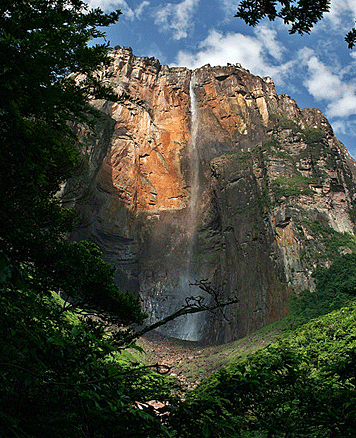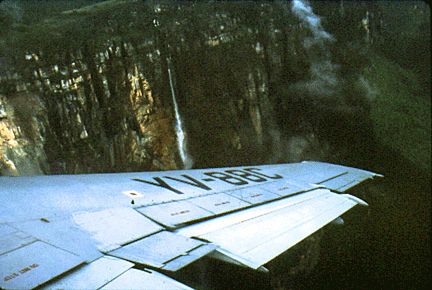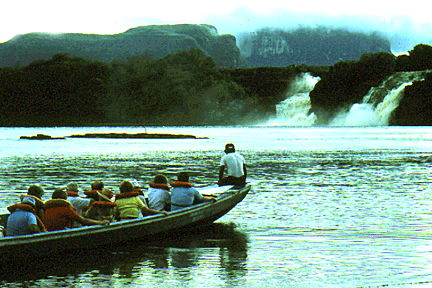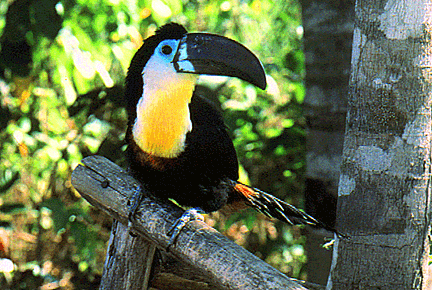|
 I
awoke at 4:30 A.M. from a dream about a lost island filled with exotic
plants and animals. Maybe it was because I was preparing for an adventure of
a lifetime–an excursion to Angel Falls, deep in the Guyana Highlands of
southeastern Venezuela, an ancient plateau stretching down into Brazil.
After all, this area not only inspired Sir Arthur Conan Doyle to write
The Lost World, a novel about a South American mountain peak populated
by dinosaurs and apes but also inspired Hollywood to produce countless lost
civilization films like “ King Kong” and “Jurassic Park.” I
awoke at 4:30 A.M. from a dream about a lost island filled with exotic
plants and animals. Maybe it was because I was preparing for an adventure of
a lifetime–an excursion to Angel Falls, deep in the Guyana Highlands of
southeastern Venezuela, an ancient plateau stretching down into Brazil.
After all, this area not only inspired Sir Arthur Conan Doyle to write
The Lost World, a novel about a South American mountain peak populated
by dinosaurs and apes but also inspired Hollywood to produce countless lost
civilization films like “ King Kong” and “Jurassic Park.”
A day trip to Camp Canaima from any one of Venezuela's
tourist centers means rising before dawn. It was 7:20 A.M. when 90 other
tourists and I boarded a 727 Avensa (Venezuelan Airlines) jet upstream on
the Orinoco River at Ciudad Bolivar, for what I thought was to be a short
flight to Devil’s Canyon where, if I were lucky, I’d see Angel Falls, in
Spanish Salto Angel or in the local Pemon language, Kerepakupai Vená,
meaning "waterfall of the deepest place." the highest and most remote
waterfall in the world. I soon found out how wrong I was.
The jungle labyrinth below soon revealed the downstream waters of the Carrao
and the Charun rivers where seven cascades converged into a lagoon of an
incredible sherry-red color, produced by the interaction of minerals with
the decomposition of plant roots along the shore. Camp Canaima, an oasis in
the 11,500-square-mile Canaima National Park, the sixth largest in the world
encompassing an area larger than Belgium, spreads out along its shore. Two
flat-topped promontories known as tepuis rose up through the mist, as the
deafening roar of the falls filled the moist air.
During the nearly three hours at the camp, I had the opportunity to take a
motorized canoe ride to get a closer look at the seven huge waterfalls. The
ride was not without its exciting moments, as the water swirled about and
the spray splashed me all over. Struck by the beauty of it all, I had to
agree that Canaima was a “corner of Eden.”
Going to the Falls
 But
the best was yet to come. The flight to Angel Falls was nothing short of
spectacular. The pilot flew his 727 jet sideways down into
the 4,000-foot-deep Diablo Canyon so that we could view the falls. The plane
seemed to float on the air currents like a feather as the pilot maneuvered
it below cloud level and the canyon rim. This was the first time I had ever
flown in a jet and looked up at land! I held my breath as it glided over
moss green jungle, broken only by multi-colored rivers snaking their way
over table-top mesas, eventually falling in waterfalls to the valley floor.
White knuckling it or not, I had to agree that this was a sample of some of
the best flying anywhere. But
the best was yet to come. The flight to Angel Falls was nothing short of
spectacular. The pilot flew his 727 jet sideways down into
the 4,000-foot-deep Diablo Canyon so that we could view the falls. The plane
seemed to float on the air currents like a feather as the pilot maneuvered
it below cloud level and the canyon rim. This was the first time I had ever
flown in a jet and looked up at land! I held my breath as it glided over
moss green jungle, broken only by multi-colored rivers snaking their way
over table-top mesas, eventually falling in waterfalls to the valley floor.
White knuckling it or not, I had to agree that this was a sample of some of
the best flying anywhere.
Angel Falls barely makes contact with the cliff over which it flows. About
15 times higher than Niagara Falls, it plunges 3,212 feet—determined by the
National Geographic Society in 1949—and is about 500 feet wide at its base,
from which the water flows into the Kerep River, then flows into the Churun
River, a tributary of the Carrao River that flows into the lake at Camp
Canima. It was unknown to the rest of the world until 1930s. Overland access
is difficult, and because of the dense jungle surrounding it, the waterfall
is still best seen from the air.
Modern Man Discovers the Falls
 Although
the local Indians had known of its existence for thousands of years, the
earliest recorded sighting was by Venezuelan explorer Ernesto Sanchez La
Cruz in 1910 although some historians believe that Fernando de Berrío, a
Spanish explorer and governor from the 16th and 17th centuries, was the
first European to visit it. However the name comes from the American
bush-pilot Jimmy Angel, who first flew over the area in 1921. He flew in
from Panama, where he had been paid $5,000 by an old prospector to fly to
and land on the flat-topped plateau called Auyan-Tepui, which means "Devils
Mountain," where they allegedly found a stream, and panned considerable
quantities of gold. Although
the local Indians had known of its existence for thousands of years, the
earliest recorded sighting was by Venezuelan explorer Ernesto Sanchez La
Cruz in 1910 although some historians believe that Fernando de Berrío, a
Spanish explorer and governor from the 16th and 17th centuries, was the
first European to visit it. However the name comes from the American
bush-pilot Jimmy Angel, who first flew over the area in 1921. He flew in
from Panama, where he had been paid $5,000 by an old prospector to fly to
and land on the flat-topped plateau called Auyan-Tepui, which means "Devils
Mountain," where they allegedly found a stream, and panned considerable
quantities of gold.
The prospector, having sold his haul for $27,000, subsequently died, and it
wasn’t until 1935 that Angel returned, and found the falls that now bear his
name. Two years later, in 1937, he attempted a
landing, but despite a successful touchdown, the aircraft nose-dived when it
hit soft ground at the end of its landing run and Angel, his wife, Marie,
and his companion, Gustavo Henry Gardener, had to hike out. Luckily,
Gardener had previously climbed the tepui, and so was able to guide the
party down the south flank, descending more than 2,000 feet through dense,
rugged jungle, a trip that took them 11 days. The plane remained
there until 1970, when it was taken out by helicopter to the Aviation Museum
at Maracay for restoration and then to its final resting place outside the
airport terminal at Ciudad Bolivar.
 True
to its exotic image, the Gran Sabana is a spectacular destination of
multicolored rivers, impressive cascades that
plunge a thousand feet off mountain tops or churn over tiered sandstone
platforms, pink and orange hued beaches, and lush tropical forests. In the
midst of it, Angel Falls plunges down, then springs up again into the
rain-laden air to paint the most brilliant double rainbow I had ever seen.
The Incas would have said that Mother Earth was very happy in her mating
with Father Sky! True
to its exotic image, the Gran Sabana is a spectacular destination of
multicolored rivers, impressive cascades that
plunge a thousand feet off mountain tops or churn over tiered sandstone
platforms, pink and orange hued beaches, and lush tropical forests. In the
midst of it, Angel Falls plunges down, then springs up again into the
rain-laden air to paint the most brilliant double rainbow I had ever seen.
The Incas would have said that Mother Earth was very happy in her mating
with Father Sky!
The local Kamara Cota Indians speak of Angel Falls as Tulume Bena in
Spanish, or Churun Meru in their language. For them, this is a dangerous,sacred
place. The falls are angry, and the Indians avoid speaking the name of the
nearby mountain as this could cause harmful rains and thunderstorms. One
elderly man reported that the Inca gods are still present here, as evidenced
by the sounds of night in the jungle.
The sheer height of Angel Falls is unrivaled, and the transcendent feeling
of being here in the rainy season when the flow of water is at its peak is
almost beyond description .
Avensa flies three times daily into Canaima over the spectacular falls.
Package tours, including one or two nights accommodations at Camp Canaima,
where most tourists stay to enjoy the swimming in the red lagoon fed by
seven waterfalls of the Carrao River, are available. It’s advisable to book
in advance as accommodations are limited, especially during the holiday
seasons. Though Angel Falls is Venezuela's best-known tourist attraction,
it's no Niagara. In the dry season, there's no guarantee it will be much
more than a trickle. And there's no guarantee in any season that the clouds
will lift enough to make it visible. But time and Mother Nature have
combined to make this place feel like another world.
< Back to
Travel Articles
Go to next article >
|
